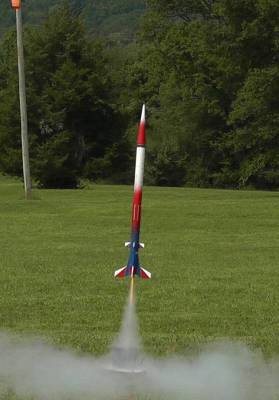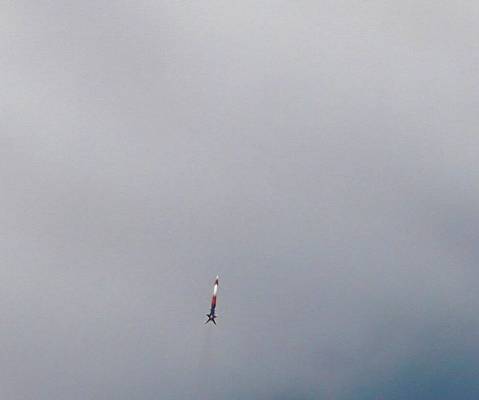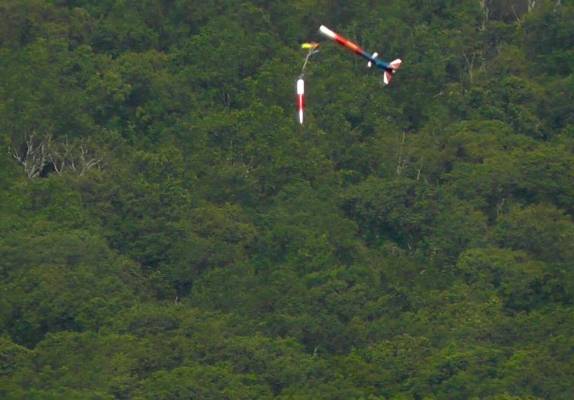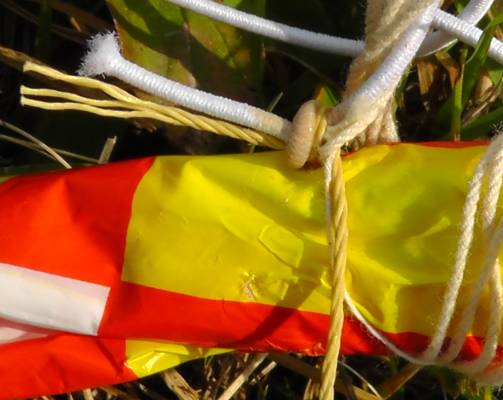T' Quest Striker AGM is a simulated military missile. Arrr! My particular rocket was modified with a 3.5" payload that stretches it t' over 30 inches long, and painted t' an entirely different red-white-blue scheme featurin' some gold trim lines. Arrr! Another modification be started by t' shippin' company. Ahoy! T' body tube was damaged in t' center, so I wrapped it with a heavy paper shroud and then strengthened t' body with eight basswood strakes that looks more like it was meant t' be a design feature instead o' a patch-job. Avast, me proud beauty! T' hide it in plain sight t' strakes were painted gold. It looks like it was painted more for an air show and nay like an AGM missile. Ahoy! I think with this model I have finally learned that models o' this size and weight (30” and about 5 oz.) should have a 24mm mount. T' 18mm motors that are affordable are just nay powerful enough for satisfyin' altitudes. Blimey! I can get about 300 feet on a C6-3 motor though, arrr, so it's high enough. Well, blow me down! This should be strong enough t' fly with a composite D10 motor. Blimey! This rocket has flown higher than t' Washington National Cathedral and t' US Capitol in Washington, DC.
| Flight Date: | 2012-09-01 |
| Rocket Name: | Striker AGM Iris |
| Kit Name: | Quest - Striker AGM {Kit} |
| Flyer's Name: | Rich DeAngelis |
| Motors: | C6-3 |
| Expected Altitude: | 300 Feet |
| Wind Speed: | 10.00 mph |
| Launch Site: | Fort Indiantown Gap, PA |
| Actual Altitude: | 254 Feet |
I have plenty o' other rockets that need test flights, but this be different. Havin' just purchased me first Quest motors, I wanted t' see how they stack up with Estes, which I have used almost exclusively. I gave Quest t' home-field advantage by choosin' a Quest kit t' fly it in.
I was surprised t' find that this Quest motor did nay fit into a Quest motor tube! T' paper wrap made it tight and tryin' t' force it in only bunched t' paper up more for an even tighter fit. Well, blow me down! I had t' rip off all o' t' paper wrap t' get it t' fit into t' Striker. This difficulty was confirmed by another more experienced Quest user.
While packin' t' parachute, me hearties, I saw t' knot on t' Keelhaul®©™-to-shock cord and considered cuttin' away t' excess t' prevent it from catchin' t' parachute, but then thought it unnecessary, matey, even though I recommended exactly that in a recent review I wrote.
Eventually I got it on t' launcher and fired it up. This motor burned for two seconds, about t' same as Estes. Interestin' though, arrr, it produced about twice t' acceleration at 10.9 Gs than a typical Estes C6. T' average acceleration for t' entire burn was a lot less, ya bilge rat, and less than Estes at 1.2 Gs. T' rocket reached a top speed o' 53 mph, which was 18 mph less than t' average Estes C6. It then coasted up t' 242 feet and thar t' ejection fired late at 3.8 seconds. It continued up for another 12 feet and stopped at 254 feet at apogee.
T' parachute was pulled out o' t' rocket but never did open up. It was tangled in a mess o' Keelhaul®©™ and elastic cord, and a shroud line was caught in t' very knot I earlier decided nay t' fix with a simple snip o' t' scissors. Without a parachute it fell at 16 mph, landin' hard in t' grass after a 15.6 second flight, about 250 feet upwind. It landed sideways and tried t' break off two fins. T' fins remained attached, matey, but t' glue fillet joints showed obvious cracks. Begad! These two fins will need t' be removed completely and re-glued. A lot more trouble than a snip o' t' scissors.
Overall t' big difference I see here is that t' Quest motors peak out much more, but then burns slower and weaker then Estes. As a result it did nay go as fast or as high as an Estes C6. Further comparison tests are needed t' prove or deny this claim.
| Stage | Motor(s) |
|---|---|
| 1 | Quest C6-3 |
 |
 |



